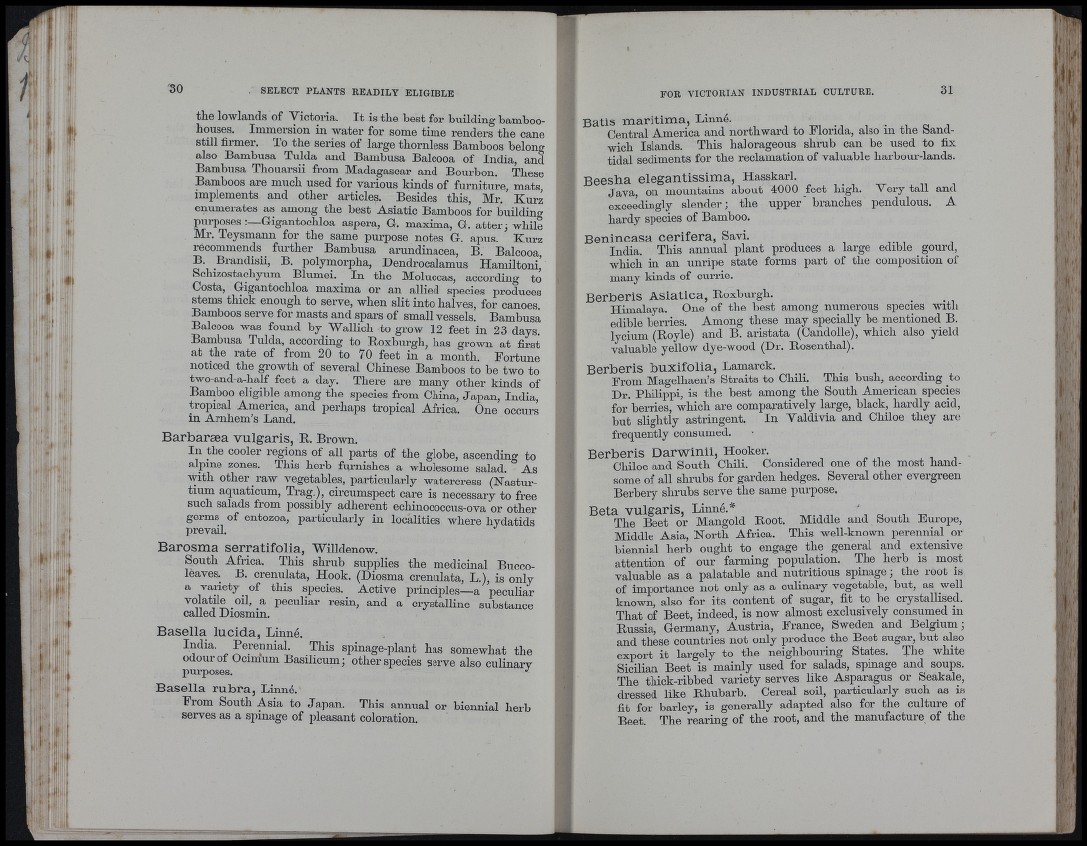
K.
í
the lowlands of Victoria. I t is the best for building bamboo-
houses. Immersion in water for some time renders the cane
still firmer. To the series of large thornless Bamboos belong
also Bambusa Tulda and Bambusa Balcooa of India, and
Bambusa Thouarsii from Madagascar and Bourbon. These
Bamboos are much used for various kinds of furniture, mats
implements and other articles. Besides this, Mr. Kurz
enumerates as among the best Asiatic Bamboos for buildincr
purposes : Gigantocliloa aspera, G. maxima, G. atter ; while
Mr. Teysmann for the same purpose notes G. apus. Kurz
recommends further Bambusa arundinacea, B. Balcooa,
B. Brandisii, B. polymorpha, Dendrocalamus Hamiltoni’
Scbizostacliyum Blumei. In the Moluccas, according to
Costa, Gigantochloa maxima or an allied species produces
stems thick enough to serve, when slit into halves, for canoes.
Bamboos serve for masts and spars of small vessels. Bambusa
Balcooa was found by Wallich to grow 12 feet in 23 days.
Bambusa Tulda, according to Roxburgh, has grown at first
at the rate of from 20 to 70 feet in a month. Fortune
noticed the growth of several Chinese Bamboos to be two to
two-and-a-half feet a day. There are many other kinds of
Bamboo eligible among the species from China, Japan, India,
tropical America, and perhaps tropical Africa. One occurs
in Arnhem’s Land.
Barbaræa vulgaris, R. Brown.
In the cooler regions of all parts of the globe, ascending to
alpine zones. This herb furnishes a wholesome salad. As
with other _ raw vegetables, particularly watercress (Nasturtium
aquaticum, Trag.), circumspect care is necessary to free
such salads from possibly adherent echinococcus-ova or other
germs of entozoa, particularly in localities where hydatids
prevail.
Barosma serratifolia, Willdenow.
South Africa. This shrub supplies the medicinal Buccoleaves.
B. crenulata. Hook. (Diosma crenulata, L.), is only
a variety ^ of this species. Active principles—a peculiar
volatile oil, a peculiar resin, and a crystalline substance
called jDiosmm.
Basella lucida, Linné.
India. Perennial. This spinage-plant has somewhat the
odour of Ocim’um Basilicum; other species serve also culinarv
purposes.
Basella rubra, Linné.
From South Asia to Japan. This annual or biennial herb
serves as a sjiinage of pleasant coloration.
Batis marítima, Linné. , • . l o . .
Central America and northward to Florida, also in the Sandwich
Islands. This halorageous shrub can be used to fix
tidal sediments for the reclamation of valuable barbour-lands.
Beesba elegantissima, Hasskarl.
Java, on mountains about 4000 feet liigb. Very tall and
exceedingly slender; the upper' branches pendulous. A
hardy species of Bamboo.
B e n in c a s a cerífera, Savi.
India. This annual plant produces a large edible _ gourd,
which in an unripe state forms part of the composition of
many kinds of ciirrie.
Berberís Asiática, Roxburgh.
Himalaya. One of the best among numerous species with
edible berries. Among these may specially be mentioned B.
lycium (Royle) and B. aristata (Candolle), which also yield
valuable yellow dye-wood (Dr. Rosenthal).
Berberís buxifolia, Lamarck.
From Magelbaen’s Straits to Cliili. This busli, according to
Dr. Philippi, is the best among the South American species
for berries, which are comparatively large, black, hardly acid,
but slightly astringent. In Valdivia and Cbiloe they are
frequently consumed.
Berberís Darwinii, Hooker.
Chiloe and South Chili. Considered one of the most handsome
of all shrubs for garden hedges. Several other evergreen
Berbery shrubs serve the same purpose.
Beta vulgaris, Linné. -n
The Beet or Mangold Root. Middle and South Europe,
Middle Asia, North Africa. This well-known perennial or
biennial herb ought to engage the general and extensive
attention of our farming population. The herb is most
valuable as a palatable and nutritious spinage; the root is
of importance not only as a culinary vegetable, but, as well
known, also for its content of sugar, fit to be crystallised.
That of Beet, indeed, is now almost exclusively consumed in
Russia, Germany, Austria, France, Sweden and Belgium;
and these countries not only produce the Beet sugar, but also
export it largely to the neighbouring States. The white
Sicilian Beet is mainly used for salads, spinage and soups.
The thick-ribbed variety serves like Asparagus or Seakale,
dressed like Rhubarb. Cereal soil, particularly such as is
fit for barley, is generally adapted also for the culture of
Beet. The rearing of the root, and the manufacture of the
j
il